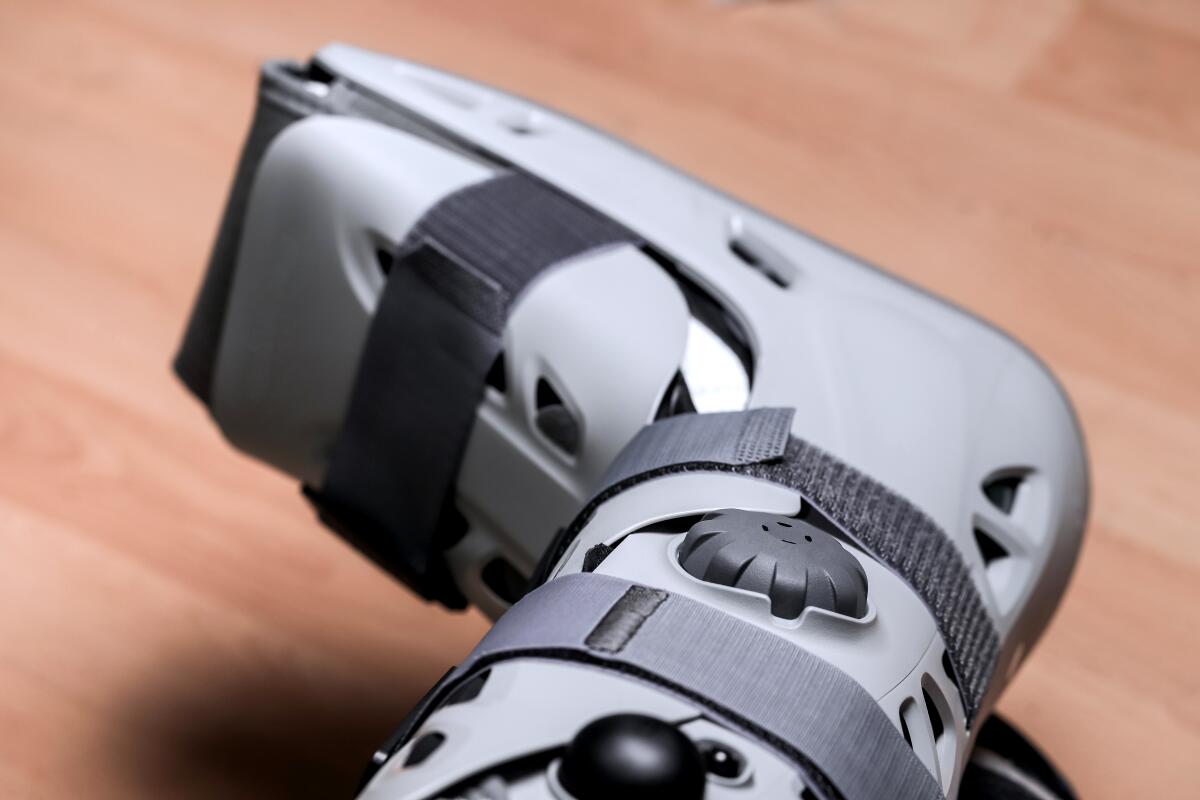Column: She was billed $809 for a boot for her broken foot. Amazon charges $80

Stephanie Noonan Drachkovitch recently broke her foot while horseback riding. She got treated at a UCLA-affiliated orthopedic facility in Thousand Oaks and has no complaints about the quality of care.
“My doctors were fantastic,” Drachkovitch told me. “This isn’t about them.”
What this is about, as you’ve probably already guessed, is her subsequent bill for medical care — yet another example of how our healthcare system routinely rips people off with inflated, nonsensical charges.
In Drachkovitch’s case, what caught her attention was the bill’s $809 charge for the plastic walking boot that was placed on her foot after the injury.
“I was like, ‘Whoa, really?!’ ” the Valley Village resident told me. “That’s a lot of money!”
Drachkovitch isn’t a neophyte when it comes to finances. She’s co-founder and co-chief executive of Burbank’s 44 Blue Productions, a maker of unscripted and documentary TV shows.
“As a CEO myself, I understand margins, I understand making a profit,” Drachkovitch said, adding that a markup “as high as 30%” for the treatment she received wouldn’t have been out of line.
Out of curiosity, she did a search for her foot boot, the AirCast AirSelect. She found it on Amazon for about $80.
Wait, $80? And UCLA billed her more than $800? A nearly 1,000% markup?
“I assumed the price on my bill had to be a typo,” Drachkovitch said. “It had to be.”
It wasn’t.
Visitors to the Trader Joe’s in Hollywood are being instructed to download a parking app to their phones. Doing so will reveal a lot about you.
Drachkovitch said a UCLA service rep looked into her bill and, you guessed it, no typos. The Thousand Oaks clinic was seriously, actually charging $809 for something you can buy online for a small fraction of that cost.
This is all too typical of the $4-trillion U.S. healthcare system, which charges the world’s highest prices for treatment and forces Americans to pay roughly double what people in other developed countries pay for care.
Not coincidentally, a 2019 study found that medical bills were a primary factor in about two-thirds of U.S. personal bankruptcy filings. More than half a million U.S. families go bankrupt annually because they can’t afford healthcare.
This is due in large part to doctors and hospitals routinely billing insurers ludicrous amounts to bump reimbursement rates higher.
List prices for healthcare, known as the “chargemaster,” generally bear no relation to actual costs. A 2016 study found that most hospital chargemaster prices are four times greater than the actual cost of providing treatment.
Some healthcare services, such as CT scans, may be billed at levels nearly 30 times higher than the true cost, the study found.
Yet even by the ridiculous billing standards of the U.S. healthcare system, the almost 1,000% markup experienced by Drachkovitch is extraordinary — a sign of breathtaking corporate greed.
She decided to share her concerns with senior administrators of UCLA Health.
“It’s not just another example of a hospital overcharging consumers, but it also raises moral and ethical questions for those who cannot afford healthcare,” Drachkovitch told them. “How many Angelenos can afford an $809 AirCast?”
This led to an emailed response from Anton Loman, director of UCLA’s Physicians’ Billing Office.
He said there was an error in Drachkovitch’s bill. Her insurer, Anthem Blue Cross, “made a claim processing error and allowed 100% of the charge,” Loman said.
Instead of $809, Drachkovitch should have been billed $639, he said.
Oh, well, that makes everything OK. That’s a markup of only about 700%.
In California, you can’t be sued for consumer debt older than four years. But making even a partial payment can restart the debt clock.
Loman also noted that Medicare allows a charge of $346 for the AirCast boot, which is still about five times the Amazon cost.
He told Drachkovitch it’s “unfortunate” that rising insurance deductibles and co-insurance payments have caused an “exponential increase” in patients’ out-of-pocket costs — a backhanded way of blaming insurers for the high prices his and other hospitals charge.
Drachkovitch shared her bill with me. Along with the original $809 charge for the $80 boot, she was billed nearly $300 for X-rays, $68 for aluminum crutches and $864 for treatment of her foot.
The total bill was for $3,115. With insurance, Drachkovitch’s share of the cost was $720, subsequently lowered to $550 because of the billing error.
“It breaks my heart that this is the bill people get,” she told me. “How many people, especially those without insurance, can pay this?”
UCLA and other medical providers typically offer discounts and financial assistance to cash-strapped patients, but this only perpetuates the problem.
It allows those wildly inflated chargemaster prices to continue defining the base cost of medical care in this country, rather than doctors and hospitals charging amounts that reflect actual medical costs (with a reasonable markup).
“Negotiated rates take into account not only the cost of the product but also clinical staff’s time and expertise in fitting the items, counseling patients regarding proper use and other direct and indirect expenses,” Phil Hampton, a UCLA Health spokesperson, told me.
“We know health insurance, billing and costs can be complicated, and we encourage patients with questions to contact our agents for clarification, facilitation of resolution with insurers if needed and potential financial assistance,” he said.
“How can anyone defend an $800 boot?” Drachkovitch responded. “Rather than offering financial assistance, UCLA should take the lead in charging a fair price.”
That would be nice, but no single medical institution can go it alone in reforming the healthcare system.
In a strangely threatening letter, cable giant Spectrum warns a former customer he’ll be reported as a deadbeat unless he renews his subscription.
What’s needed is systemic reform — a complete reinvention of how medical care is delivered in this country that allows providers to make a decent profit without leaving many patients destitute.
“Medicare for all” might not hold all the answers. But it would at least put us on the same footing (pardon the pun) as our economic peers abroad, which deliver the same if not better care for roughly half the cost per person.
“It’s just so dumb that we say we can’t fix this,” Drachkovitch said. “We can fix this.”
All we need is the courage to try.










